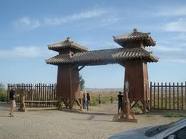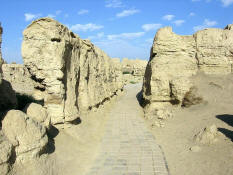
Silk Road Trade & Travel Encyclopedia
丝绸之路网站(丝路网站)
丝绸之路百科全书—游客、学生和教师的参考资源
İPEK YOLU
ve YOLLARI
ANSİKLOPEDİSİ
www.ipekyollari.net
J
A B
C
D
E
F
G
H I
J
K
L
M
N O P
Q
R
S
T
U V
W
X
Y
Z
Jade is an ornamental stone that been used in virtually all periods of Chinese history,
and has been prized by the Chinese for its durability,
its subtle, translucent colors, its alleged protective powers, as well as for
its musical qualities as a gem. It was imported from the western regions to
China.
Jade Gate Pass (Yumen, Yumenguan) dates from the Han dynasty era (206 BC-220 AD).
The Silk Road
began at the capital city of Chang'an (Xi'an) and went west into Gansu Province
and along the Hexi Corridor to the Great Wall. From here many merchants would
travel upon the northern route through the Jade Gate Pass, northwest of Dunhuang,
along the southern foothills of the Heavenly Mountains (Tian Shan), thus
skirting the northern rim of the Taklamakan Desert and passing by the rich oasis
towns of Hami, Turpan, Yanqi, Korla, Kucha and Kashgar. (Other caravans would
take the Yangguan Pass, the southwest route of Dunhuang, along the northern foothills of
the Kunlun Mountains and the southern edge of the Taklamakan to Loulan, Khotan,
Yarkand and Kashgar.)

The Jade Gate marks the beginning of the North Route of the Silk Road around
the Taklamakan Desert leading through the Turpan Oasis, and eventually to
Kashgar. (See Yumenguan Pass)
Jade Road An ancient trade route whose artifacts are displayed
at the
Silk Route Museum of China. From the 2nd millennium BCE
nephrite jade was being
traded from mines
in the region of
Yarkand and
Khotan to China.
Significantly, these mines were not very far from the
lapis
lazuli and
spinel ("Balas Ruby") mines in Badakhshan
and, although separated by the formidable
Pamir Mountains, routes across them were in use from very early
times.

Jaohe The ancient city of Jaohe, in the Uyghur Autonomous Region of
Xinjiang, China, was an important site along the
Silk Road trade route
leading west. More...

Japan (Chipangu, Cipango) As a result of the Mongolian conquest of Korea, Japan became a
target for Mongol overseas expansion. Japan was invaded by Kublai Khan twice, in
1274, and in 1281. The Mongols first invaded Korea in 1218 as part of their
conquest of Manchuria, forcing the Koreans to pay tribute, and later formed an
alliance with the Koryo Korean state to launch an allied Mongol-Koryo invasion
of Japan (See Masan)
Map 1274
Map 1281
Java An Indonesian island which was the object of a Mongolian seaborne
invasion in 1292. This marked the farthest reach of the navy of Mongol China
(although not of its commercial ships which regularly sailed to Iran and eastern
Africa).
Jeju Island (Jeju-do, Cheju ) is located off the southern tip of the
Korean Peninsula. In the mid-13th century, after the Mongol-Yuan Dynasty forces
conquered Sambyeolcho forces, the Mongol-Yuan Dynasty established a military
governor on the island in 1273. Their rule lasted about 100 years. (See Korea)
More...
Jenkinson
Anthony Jenkinson
Representing the English Muscovy Company and
accompanied by Richard and Robert Johnson, traveled via Moscow, down the Volga River and across the Caspian Sea to Bukhara and then back
by the same route in 1557-60. In 1561-1564, via the same route to the Caspian,
Jenkinson went to Persia to try to negotiate trade agreements; and spent the winter in
Kazvin discussing the spice trade with Indian merchants. Beginning in 1546, Jenkinson had traveled widely in the Mediterranean
and the Levant.
Jiaohe Ruins The Ancient City of Jiaohe is situated at Yar Town, 10 km
west of the city of Turpan, Xinjiang province, China.. In the Western Han
Dynasty, this City served as the capital of “Anterior State of Cheshi,” one of
the 36 kingdoms in the West Region. The ruins are located between two riverbeds in the Yarnaz
Valley, like a deserted islet. It is a key historical and cultural site under
state protection.
Jiayuguan is a city that lies in the middle section of the Hexi
Corridor. It derives its name from the Jiayuguan Pass, the western terminus of
the Ming Dynasty Great Wall. Jiayuguan Pass, in Jiayuguan city, is the largest
and most intact pass, or entrance, of the Great Wall. It was built in the early
Ming dynasty, around the year 1372, near an oasis that was then on the extreme
western edge of China. Jiayuguan Pass was the first pass on the west end of the
great wall so it earned the name “The First And Greatest Pass Under Heaven.”
Jiayuguan Pass (Jiayu Pass) is one of the main passes of the
Great Wall, as well as a key waypoint of the ancient
Silk Road.
Jiayuguan Pass is famous because it is the western ending point of the Great
Wall and known as the mouth of China. Before Dunhuang was established in the second century A.D.,
the fort of Jiayuguan marked the border between the
known and the unknown. According to local tradition, travelers threw a stone at
the western wall, also called the Gate of Sorrows. If the stone reverberated, a
safe journey was ensured; if it did not, they would die among strangers. Many
historic sites and
frescos are found in the areas around Jiayuguan.
Jingjue Mosque (Sanshan Street Mosque) is one of the famous mosques in
China, located in Nanjing City, Jiangsu Province. It is said that the name of
the mosque was granted by an emperor in the Ming Dynasty (1368-1644). It was
first established in the 4th century. In 1430, advised by famous Moslem
navigator Zheng He, the government ordered to rebuild the mosque. It underwent
another large-scale reconstruction in 1492. In the mid 19th century, the mosque
was destroyed. It was rebuilt at the end of the Qing Dynasty. The gate, which
was built in the Ming Dynasty, is a brick construction with rare carvings on it.
The Jingjue Mosque is one of the most important Islamic buildings in China built
in the Ming Dynasty. The mosque contains cultural relics, including important
epigraphs left by emperors of various dynasties. The Jingjue Mosque was ordered
to be built together with the Huajue Mosque in Xi'an by Emperor Hongwu during
the Ming dynasty, c.1392.
Jiuquan A gateway to China for eastbound travelers, Jiuquan
was the first town within the Great Wall. The "Silk Route Museum" is located
here, built over the tomb of the Xiliang King in Gansu Province.
More...
John of Marignolli A Papal envoy to China who reached Daidu
(Peking) in 1342. As gift for the Mongol emperor, he brought with him powerful
horses. He is documented in the Yuanshi, "Official History of the Yuan Dynasty."
He is well known as the Franciscan sent as papal legate to the Yüan (Mongol)
Emperor of China. He entered the lands of the Golden Horde via the Black Sea. His
route probably ran through Urgench (S. of Aral Sea), via Hami (north of the
Taklamakan) to Beijing and Shang-tu, where he was received in August 1342. After
three years, he headed home via ship to Hormuz, and then overland to the Levant.
John of Monte Corvino (died c. 1329) A missionary to Mongol China and
the first archbishop to Qanbaliq. He translated the Psalter into either
Mongolian or Turkish, however the translation has not survived.
Joughayetsi
Hovhannes Joughayetsi (1682-1693) Armenian merchant who traveled and traded
between New Julfa (the Armenian suburb of Isfahan), Northern India and Tibet. He
spent five years in Lhasa. His commercial ledger is a unique source of
information on products, prices, trading conditions, and the Armenian commercial
network on the seventeenth-century routes involving the Safavid and Mughal empires.
Judaism
Like other great religions,
Judaism was spread for hundreds of centuries along the
Silk Road.
Buddhism was most certainly the
most prominent religion, but Islam, Christianity,
Judaism, Manichaeism,
and other religions were
spread along the Silk Routes.
Jewish traders and
sericulturists
(producers of raw silk, by
raising silkworms)
also played important roles along the Silk Routes. According to
The Roman Orient and the Far East, the Jews learned the secrets of
sericulture from the Chinese.
Silk was not altogether unknown in the Near East before the route to the
heart of China was secured. Silk produced from wild Asia Minor silkworms was
used among Near Eastern civilizations of the Hellenic period. Sericulture,
however, was uniquely a Chinese industry. The process of raising silkworms,
reeling off filaments hundreds of meters long from their cocoons, and weaving
them into beautiful, remarkably strong and stable fabrics dates back to the
beginning of Chinese civilization. A silk fabric found in Zhejiang Province
dates back to 2700 B.C.E.
The Jews learned the secrets of sericulture from the Chinese. The
production of silk textiles burgeoned in Persia through the first
centuries of the Common Era (the Sassanian period), to a point in
which silk fabrics were exported not only westward, but also to the
East. The demand for this genre of goods was so great in China,
Japan, and Europe that the Chinese proceeded to produce silks with
typical Persian patterns. "The most striking evidence of this is the
celebrated 'hunter' silk of the seventh-eighth century from the
treasury of the Horiuji Monastery at Nara in Japan." (See C. G.
Seligman,
The Roman Orient and the Far East, 1939). The
renowned Oriental silks thus contain Jewish iconography.
Jewish
sericulturists went from Persia to Alexandria. The
Byzantines decided to capture the industry and imported Jewish
sericulturists who founded the industry in
Thessalonika, and other Greek towns. The Norman Crusader Roger II
invaded Greece, and brought the Jewish artisans to Sicily. Later the
Spaniards conquered Sicily, and nationalized the industry. During
the Inquisition, Jewish
sericulturists fled Sicily and brought their
expertise to Tuscany, Bologna, Genoa, Venice and Piedmont. The
Ottoman city
of Bursa in Turkey also thrived as a center of silk production and trade.
More...
Julian of Hungary Hungarian envoy to the "Great Hungary" during
1235-1236 (prior to the area's conquest by the Mongols). "Great
Hungary" is the medieval name for an area in the southern Urals from
which the ancestors of the Hungarians were believed to have come.
Juyan Lake Basin is a former lake in the
Gobi desert of western
Inner Mongolia
at the Alxa
League near the border of eastern
Xinjiang in
China. The basin played an important role in ancient times and was
historically part of the Gansu Corridor between the 2nd century BC
to 8th century AD. The Juyan Lake Basin lies along the route of the
Northern Silk Road, which is about 2,600 km (1,600 mi) in length,
connecting the ancient Chinese capital of Xian to the west over the
Pamir Mountains to Kashgar, before linking to ancient Parthia.
Silk Routes.net |
Ipek Yollari.net



